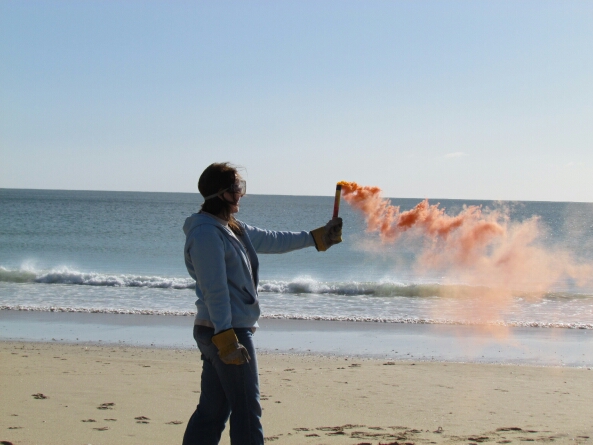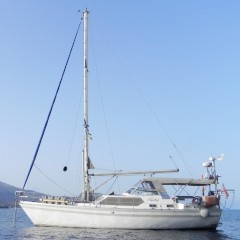
Emerald Tales
Currently in Portugal after 7 years in the Mediterranean
22 March 2024 | Las Palmas de Gran Canaria
08 March 2024 | Gran Canaria
01 March 2024 | Porto Santo
23 February 2024 | Porto Santo
02 February 2024 | Porto Santo
22 January 2024 | Madeira
15 December 2023 | Porto Santo
01 December 2023 | Porto Santo
24 October 2023 | Porto Santo
13 October 2023 | Porto Santo
15 September 2023 | Porto Santo
09 August 2023 | Porto Santo, Madeira
28 July 2023 | Porto Santo, Madeira
22 July 2023 | Porto Santo
23 June 2023 | Porto Santo
15 January 2023 | Porto Santo
15 September 2022 | Porto Santo
19 August 2022 | Porto Santo
29 July 2022 | Porto Santo, Madeira
18 June 2022 | Faro, Portugal
Flare firing fun
30 January 2014 | Lagos, Portugal
Nichola / sunny, chilly north wind

Today we had a flares exercise on the beach, organised by the marina. We got to have a go at setting off expired flares in a safe environment and supervised by the Portuguese police. It served the double purpose of experiencing firing flares and getting rid of expired ones easily.
Our last set of flares expired in December so it seemed a good opportunity to have a go, although there were plenty of spares available to let off if people didn't have their own. I had some extra goes with spares but wasn't keen on trying the one's which had expired in 1989 though!
The sun was shining and the wind was from the north which helped blow the smoke away from everyone. We were first up and I went for a parachute flare. I was quite surprised by the recoil from the flare and it felt quite awkward to fire, having to hit the trigger upwards. I later tried a ring pull type parachute which was much easier to fire.

What a parachute flare looks like in the air
Next was a red handheld. This had a cap at the top which had to be removed to release the firing string. The string was fiddly to remove, especially if wearing gloves; a gentle shake downwards released it. Hold the flare in one hand and pull the string sharply with the other and the flare fired. The red and orange smoke ran for a reasonable amount of time and I could feel the heat generated from them even with it at arms length.
It was a useful exercise (and fun!) and I was glad to have the chance to experience firing flares. However, we have mixed views as to how useful flares will continue to be in an emergency, especially as we have an EPIRB, fixed vhf and handheld radios, plus a satellite phone for use on long ocean crossings. We also have a laser torch which runs for much longer than a flare and in which we can change the batteries. Hopefully laser flares or some other more reliable way of getting attention will become standard and the need to carry time-expiring fireworks on board and keep them up to date will go away.

Fire!
Lessons learned:
- read the instructions! There were many different types that we used, some where you hit the bottom to fire, others with ring pulls. Perhaps the best learning to take away would be to familiarise ourselves with how our flares work before we need them in an emergency situation (which hopefully will never happen), as in the rush of an emergency reading instructions might be the last thing on our minds.
- beware the recoil from the parachute flares. There were some minor injuries caused from this.
- wear gloves, something like gardening gloves are good and keep them with the flares. The hand held flares get hot, paint even flaked off a flare which would cause a bad burn if it fell onto bare skin.
Our last set of flares expired in December so it seemed a good opportunity to have a go, although there were plenty of spares available to let off if people didn't have their own. I had some extra goes with spares but wasn't keen on trying the one's which had expired in 1989 though!
The sun was shining and the wind was from the north which helped blow the smoke away from everyone. We were first up and I went for a parachute flare. I was quite surprised by the recoil from the flare and it felt quite awkward to fire, having to hit the trigger upwards. I later tried a ring pull type parachute which was much easier to fire.

What a parachute flare looks like in the air
Next was a red handheld. This had a cap at the top which had to be removed to release the firing string. The string was fiddly to remove, especially if wearing gloves; a gentle shake downwards released it. Hold the flare in one hand and pull the string sharply with the other and the flare fired. The red and orange smoke ran for a reasonable amount of time and I could feel the heat generated from them even with it at arms length.
It was a useful exercise (and fun!) and I was glad to have the chance to experience firing flares. However, we have mixed views as to how useful flares will continue to be in an emergency, especially as we have an EPIRB, fixed vhf and handheld radios, plus a satellite phone for use on long ocean crossings. We also have a laser torch which runs for much longer than a flare and in which we can change the batteries. Hopefully laser flares or some other more reliable way of getting attention will become standard and the need to carry time-expiring fireworks on board and keep them up to date will go away.

Fire!
Lessons learned:
- read the instructions! There were many different types that we used, some where you hit the bottom to fire, others with ring pulls. Perhaps the best learning to take away would be to familiarise ourselves with how our flares work before we need them in an emergency situation (which hopefully will never happen), as in the rush of an emergency reading instructions might be the last thing on our minds.
- beware the recoil from the parachute flares. There were some minor injuries caused from this.
- wear gloves, something like gardening gloves are good and keep them with the flares. The hand held flares get hot, paint even flaked off a flare which would cause a bad burn if it fell onto bare skin.
Comments
| Vessel Name: | Emerald |
| Vessel Make/Model: | Kelly Peterson 44 |
| Hailing Port: | No fixed abode |
| Crew: | Colin 'Skip' Wright, Nichola Wright |
| About: | One from Northern Ireland, one from Yorkshire, UK |
| Extra: | Emerald has been our home since 2004. We've sailed around the UK, the western Baltic and have spent 7 years in the Med. We're currently in Portugal, planning a refit. Lot's more information about us and the boat can be found at www.yachtemerald.com |
| Home Page: | https://www.yachtemerald.com/ |
| Social: |
Gallery not available
Emerald

Who: Colin 'Skip' Wright, Nichola Wright
Port: No fixed abode
Favorites
- Winter 2023/24
- 2023: Engine
- 2022: Summer
- 2021: Refit
- 2021: Summer in Portugal
- Winter & Spring in Portugal
- 2020: Spain & Portugal
- 2019: Western Med
- 2015: Summer in the Ionian
- 2014\15: Winter in Sicily
- 2014: Into the Med. Balearics, Sardinia, Sicily
- 2013\14: Algarve autumn and winter
- 2013: In search of warmer climes
- 2013: Brandy Hole winter
- 2011\12: Winter jobs at Brandy Hole
- 2010: Winter in Falmouth
- 2009: Brighton to Falmouth and Back
- 2010: Western Baltic & Western UK
- 2011: Around the UK
- Show All Posts




